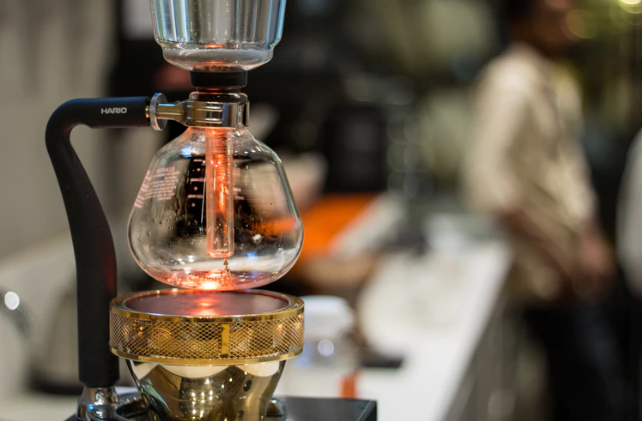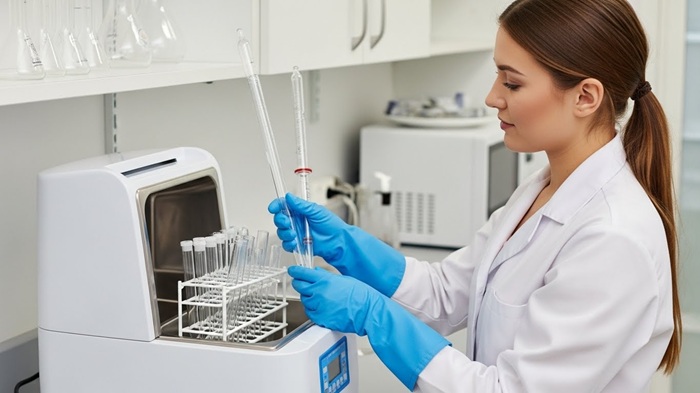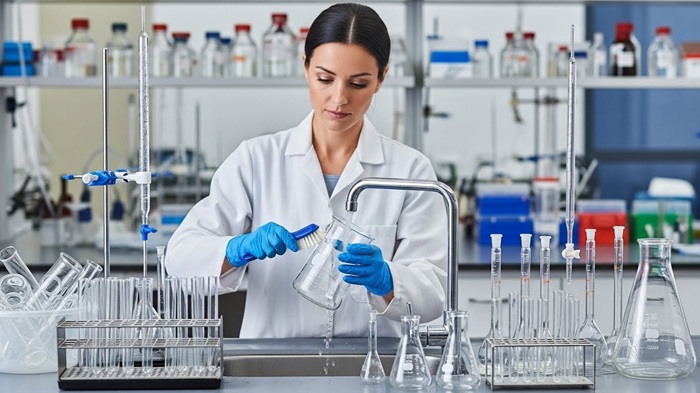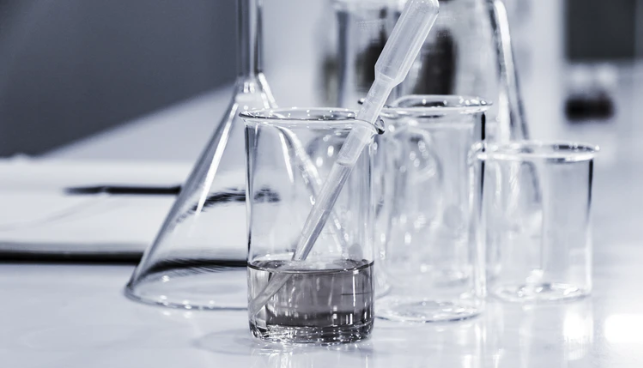
Unlike surgical instruments, lab instruments are tools used for scientific research, analysis, and experimentation. They help in measuring, analyzing, or manipulating substances and materials in laboratories, typically for chemical, biological, or physical studies.
Especially when we talk about lab glassware, these include beakers, flasks (for holding or mixing liquids), and burettes (for measuring liquid volumes).
Since cleaning stained laboratory glassware is essential for both your safety and the success of your experiment, it’s important to know the proper cleaning methods to maintain the glassware’s integrity and achieve accurate results.
In this guide, we’ll go over just how to do this, what tools and solutions to use, and what to avoid, so you’re prepared next time you need to do some lab cleaning.
Washing Different Types of Laboratory Glassware
Keep in mind that different glassware types require different cleaning strategies based on bore diameter, wettability, calibration precision, and chemical compatibility.
Here are the correct methods for cleaning various classes of volumetric and general-purpose glassware, along with a solvent-selection table for removing specific residues safely.
1. Pipettes and Micro-Pipettes
Precision dispensing tools like pipettes must retain perfect internal wettability and laminar flow to maintain calibration accuracy. Incorrect cleaning can cause drainage errors, meniscus distortion, or variable delivery volumes.
Here’s an exact washing procedure you should follow for the glass pipettes :
- Immediate Pre-Rinse – Rinse pipettes with DI water as soon as they are used to prevent residues from drying in the narrow bore.
- Detergent Cleaning – Use hot laboratory-grade detergent (neutral or mildly alkaline). Avoid high-pH detergents that can etch borosilicate glass over time.
- Mechanical Cleaning – Use a soft, correctly sized pipette brush ONLY if necessary. Excessive force can scratch the inner surface, altering capillary behavior.
- Rinsing Sequence – Thoroughly rinse with tap water, then follow with 3–4 DI water rinses to remove ionic residues. For analytical work, finish with a rinse of the working solution (acid, base, or titrant) to stabilize the internal surface tension.
- Drying – Pipettes should air dry inverted in a dust-free pipette stand.
Keep in mind that towel drying introduces fibers; blow-drying can cause static and contamination. Vacuum drying, if needed, is acceptable when done gently and under guidance.
2. Burettes and Micro-Burettes
Burettes have precision-ground internal surfaces and a high sensitivity to residual films. Even micrograms of detergent can alter droplet formation at the tip and change titration endpoints.
Here is a cleaning protocol to follow for burettes and micro-burettes in the lab.
- Detergent Wash – Wash with hot, soapy water or non-phosphate lab detergent. For micro-burettes, soak vertically to avoid trapped air pockets.
- Scrubbing – Use a flexible burette brush only if residue remains. Avoid scraping the stopcock barrel.
- Stopcock Care – Remove the stopcock and wash it separately. Lightly lubricate with PTFE or silicone grease (if required by design).
- Rinse – Rinse with tap water until all detergent is gone. Follow with several DI water rinses.
- Drying – Let burettes air dry upright. Avoid hot air drying—it causes thermal stress and can crack the narrow bore.
TIP: Before use, condition the burette with a small volume of titrant and discard that portion.
3. Beakers, Volumetric Flasks, and Graduated Cylinders
These vessels, especially volumetric flasks, are calibration-sensitive. Scratching, heat shock, or abrasive detergents can permanently affect accuracy.
A general washing method you should follow for beakers, flasks, and graduated cylinders is as follows:
- Detergent Wash – Clean with hot lab detergent solution. Allow overnight soaking for stubborn precipitates or dried solutes.
- Mechanical Cleaning – Use non-abrasive brushes. Never use steel wool or aggressive scrubbers that can remove graduation marks.
- Rinsing – Rinse with tap water followed by 3–4 DI rinses until the surface drains uniformly without droplets. Droplet formation can cause residual oil or detergent.
- Drying – Air drying is the default.Oven drying at <60°C is allowed for borosilicate glass.
- Avoid stacking flasks or cylinders – Volumetric glassware is thin-walled and highly susceptible to thermal and mechanical shock.
TIP: For extremely cloudy glassware, a brief exposure to a mild acid bath (e.g., 1 M HCl) may restore clarity, followed by extensive DI rinsing.

Can You Clean the Glass Flask and Beaker in Ultrasonic Cleaner?
Ultrasonic cleaning is perfectly safe for most types of laboratory glassware, including flasks, pipettes, beurettes, beakers, test tubes, and microscope slides.
Beyond the lab, it’s also a great choice for cleaning other glass items like delicate glass ornaments, precision glass instruments, scientific and optical tools, and even your vintage wine bottles.
For getting superior cleaning results, you must choose a sonicator device that comes with a larger rinsing tank and heating element (to heat the liquid solution).
These machines harness the power of high-frequency sound waves to create a symphony of microscopic bubbles.
Through the magic of cavitation, these tiny powerhouses dive into the most hard-to-reach nooks, launching an all-out assault on dirt and debris. The result you get is sparkling clean surfaces and an applause-worthy cleaning performance.
Steps for using an ultrasonic cleaner for lab glassware:
- When using the Ultrasonic cleaner device, carefully arrange the used lab glassware in the stainless-steel basket provided by the machine.
- Add the cleaning solution meant to clean glassware. Generally, de-ionized water will do the job but a specialized solution can also be used if you require it.
- Keep a note that the surface that needs the cleaning gets properly immersed in the ultrasonic cleaning solution.
- Now turn on the device and set your preferred time and temperature for cleaning (this should generally be based on the level of cleaning you require).
- At the end of the cleaning cycle, inspect the glassware and remove it carefully from the basket. Rinse it in water and let it dry naturally.
Be aware that with regular use, the ultrasonic cleaning solution may become ineffective over time. So, consider disposing of the old solution safely and replacing it with a new one periodically.
Can an Ultrasonic Cleaner Break Glass Beakers?
In general, laboratory-grade borosilicate glass (e.g., Pyrex, Duran) is strong enough to withstand ultrasonic cavitation. So, ultrasonic baths routinely clean glassware such as volumetric flasks, beakers, pipettes, and watch glasses without issue.
However, glass can crack or shatter when one or more of the following conditions are present:
1. Direct contact with the metal tank
If a glass beaker rests directly on the stainless-steel bottom of the ultrasonic tank:
- The high-energy cavitation zone at the bottom is too intense.
- Micro-vibrations transfer directly into the glass, increasing stress.
This can lead to cracks, chips, or catastrophic failure.
Prevention: Always use a basket, beaker holder, or rubber/silicone stand-off so the beaker floats or is suspended.
2. Pre-existing micro-cracks in the glass
Old or heavily used glassware may have hairline cracks that become weak points under ultrasonic vibration.
Cavitation creates rapid pressure fluctuations (up to ~10,000 psi microscopically), which can cause fractures to propagate.
3. Using too high power / wrong frequency
- Low frequencies (25–28 kHz) generate larger, more aggressive bubbles → higher mechanical stress.
- Very high power settings also increase the likelihood of damage.
Safe frequency range for general cleaning of glass is 37–45 kHz. You should only use lower frequencies if the glass is thick/sturdy.
4. Sudden temperature change (thermal shock)
When the solution temperature changes rapidly—e.g., a cold beaker placed into a 60°C bath—it stresses the glass, making it more vulnerable to vibration damage.
5. Heavy items inside the beaker and overcrowding
If you place metal tools or dense objects inside the beaker, they may vibrate and strike the inner walls, cracking the glass. Also, if beakers touch each other inside the tank, the vibration transfer point can become a fracture point.
Precautions and a few other things to consider when cleaning lab glassware:
Ultrasonic bath cleaning, while effective for removing dirt and residues, can potentially damage the calibration of laboratory volumetric glassware.
The high-frequency vibrations generated in the ultrasonic bath can cause micro-abrasions or weaken the etched or printed calibration marks over time, especially on delicate glassware.
This can lead to inaccurate volume measurements, compromising the precision of experiments and analyses.
To prevent such damage you can:
- Opt for lower frequency and power levels if the ultrasonic cleaner allows customization.
- Limit exposure time and use softer cleaning agents specifically designed for laboratory glassware to protect calibration marks.
- Consider alternative cleaning methods, handwashing with appropriate brushes and cleaning solutions may be a safer option for delicate volumetric glassware.

Why Deep Cleaning of Lab Glassware is Crucial and Non-Negotiable?
Laboratory glassware (like beakers, test tubes, volumetric flasks, and burettes) is commonly used to house chemicals such as strong acids, bases, water-soluble solutions, water-insoluble solutions, and volatile compounds.
These items are typically made from specific types of glass, rather than materials like plastic or metal, due to their lower coefficient of expansion and greater resistance to chemical reactions.
Borosilicate glass and quartz glass are the most common materials used in the manufacturing of beakers, flasks, test tubes, ground joints, kettles, and other lab equipment.
Borosilicate glass is transparent and can endure higher thermal stress, while quartz glass can withstand extremely high temperatures and is transparent in certain parts of the electromagnetic spectrum.
One of the most crucial reasons to ensure glassware is thoroughly cleaned is safety. Even trace levels of contaminants, surfactants, organic films, or ionic residues can distort volume calibration, alter titration curves, interfere with spectroscopy, or compromise repeatability.
Residual chemicals in the glassware can also react with new substances, potentially causing dangerous reactions for you and those nearby.
To avoid such hazards, achieve success in the lab, and ensure accurate results in your studies, it’s vital to keep all vials and tubes free from contaminants, allowing you to proceed without unnecessary setbacks and follow Good Laboratory Practices (GLP).

Solvent Selection Guide for Cleaning Organic or Cloudy Laboratory Glassware
Use the table below to choose the correct solvent based on the solubility of the residue. Always ensure appropriate PPE, fume hood use, and disposal procedures.
| Type of Residue / Previous Chemical | Preferred Solvent | Secondary Solvent Option | Notes / Precautions |
|---|---|---|---|
| Water-soluble salts, buffers, acids | De-ionized water | Hot DI water | Follow with detergent wash. |
| Oils, greases, hydrophobic residues | Hexane or heptane | Petroleum ether | Avoid near heat sources. |
| Alcohol-soluble organics | Ethanol or methanol | Isopropanol (IPA) | Flammable—use in hood. |
| Polar organic compounds | Acetone | Ethyl acetate | Very fast evaporation—minimizes drying time. |
| Latex, resins, polymer films | Toluene | Dichloromethane (DCM)* | *Use only if allowed; high toxicity. |
| Biological fluids, proteins | 1–2% enzymatic detergent | Hot soapy water | Avoid heat before enzymatic treatment. |
| Surfactant scum / cloudy films | Ethanol + DI water rinse | Acetone | Ensures removal of hydrophobic film. |
Related FAQs
Can I use acetone to clean a round-bottom flask?
Yes, acetone is commonly used to clean round-bottom flasks, especially for removing residual organic solvents and drying the surface quickly due to its high volatility.
After an initial detergent wash, a small amount of acetone can be swirled and drained to speed up drying.
However, avoid using acetone if the flask previously contained strong oxidizers or reactive reagents like Grignards. Always ensure good ventilation, proper PPE, and avoid open flames due to acetone’s flammability.
Can I clean a glass pipette in the lab with H₂SO₄ solution?
Glass pipettes can be cleaned with sulfuric acid cleaning solutions (often sulfuric acid–potassium dichromate mixtures), but these are now discouraged due to toxicity and disposal hazards.
If used, they must be handled with extreme caution, using tongs and chemical-resistant gloves. Modern labs prefer alkaline detergents, enzymatic cleaners, or commercial “NoChromix” substrates with sulfuric acid.
Never leave pipettes soaking indefinitely, and always rinse thoroughly with copious distilled water after acid treatment.
Should pipets and burettes only be rinsed with hot tap water?
Hot tap water is suitable for the initial wash of pipettes and burettes because it helps remove detergents and improves drying. However, hot water alone is not sufficient for analytical work.
After washing with hot tap water, these volumetric instruments should be rinsed several times with deionized or distilled water to prevent mineral deposits or ionic contamination.
Before use, they should also be conditioned by rinsing with the solution they will measure to ensure accurate volumes.
Final Thoughts
Be aware that even the tiniest dirt on your laboratory glassware can compromise the accuracy and reliability of your experimental results. Contaminants can interfere with chemical reactions, alter measurements, and lead to erroneous conclusions.
Therefore, it is crucial to thoroughly clean glassware before and after use, employing appropriate cleaning agents and techniques, such as rinsing with distilled water or using specific solvents to remove residues.
Ultrasonic cleaning of laboratory glassware is also a go-to method for more than a few solid reasons. Chief among them is its unmatched ability to tackle delicate, intricately designed glass with impressive precision and reliability.
With a laboratory ultrasonic cleaner in your arsenal, you can bid farewell to stubborn stains and relentless grime on all types of glassware—no sweat, no scrubbing, and certainly no wasted time.
